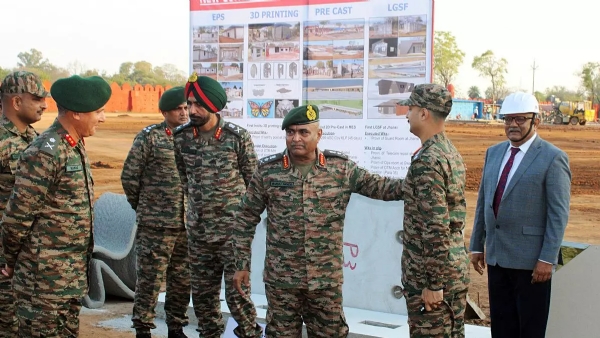STEAG, short for Signals Technology Evaluation and Adaptation Group, represents a pioneering unit tasked with researching and evaluating cutting-edge communication technologies for future military endeavors. This includes delving into realms such as AI, machine learning, software-defined radios, electronic warfare systems, and the emerging frontier of 6G networks. Embedded within the Indian Army's strategic framework, STEAG stands as a testament to the nation's commitment to technological advancement in defense..
In anticipation of evolving battleground dynamics, the Indian Army has laid the foundation for the Signals Technology Evaluation and Adaptation Group (STEAG), an unprecedented initiative poised to shape the trajectory of military technology.
STEAG's mandate encompasses the comprehensive spectrum of wired and wireless systems, ensuring readiness for the technological demands of tomorrow's warfare landscape.
Pioneering the integration of future-ready technologies, STEAG is tasked with researching and evaluating a diverse array of communication technologies. These span electronic exchanges, mobile communications, software-defined radios, electronic warfare systems, and the impending evolution of 5G and 6G networks. Furthermore, STEAG's purview extends to cutting-edge domains such as quantum technologies, artificial intelligence, machine learning, and quantum computing, all earmarked for strategic military application.

Recognizing the pivotal role of communication in modern warfare, STEAG underscores the importance of technological superiority in gaining a tactical edge over adversaries. As the dynamics of conflict continue to evolve, the ability to seamlessly connect disparate elements and facilitate information sharing will be paramount to success on the battlefield.
Anticipating the imperative of embracing 6G technology, STEAG stands poised to navigate the complexities of future military operations. With its potential to enhance command and control capabilities over unmanned military assets, 6G technology emerges as a force multiplier in shaping the future of warfare.
In the face of evolving threats and operational challenges, the induction of state-of-the-art equipment is indispensable to ensuring seamless communication support for military units and formations. Through initiatives such as STEAG, the Indian Army reaffirms its commitment to embracing technological advancements and enhancing its digital prowess on the battlefield.
What does Saudi Arabia joining the AI race mean for India?Saudi Arabia’s mammoth investment in AI signals a significant escalation in the global AI race.India faces funding challenges
While Saudi Arabia and other Gulf states surge ahead with massive investments, countries like India face the challenge of keeping pace. Despite unveiling its own AI mission, India’s investment pales in comparison, highlighting the need for alternative strategies. India aims to leverage partnerships and talent pool to compete effectively, with potential collaborations with established AI players like NVIDIA on the horizon.
With American firms leading the charge and Gulf states backing their ambitions with substantial funds, the pressure is on for nations like India to accelerate their AI initiatives.
Saudi Arabia’s mammoth investment in AI signals a significant escalation in the global AI race. As technology continues to reshape industries and economies, nations worldwide must adapt swiftly to remain competitive. The future of AI dominance hinges not just on financial prowess but also on fostering innovation, nurturing talent, and fostering strategic partnerships on a global scale.
Anti Piracy Operation Highlights India's Maritime Strength
The recent collaborative effort between the Indian Air Force (IAF) and the Indian Navy to liberate the merchant vessel MV Ruen from pirates in the Arabian Sea stands as a remarkable testament to the efficacy of Indian maritime security measures and inter-service coordination. The operation's success was marked by the precise deployment of two combat boats via the IAF's C-17 heavy-lift aircraft, complemented by the swift action of the Navy's MARCOS commandos. This resulted in the surrender of 35 pirates and the safe release of the vessel and its crew. Furthermore, the proactive stance exhibited by the Navy, reinforced by the presence of vessels like INS Kolkata and INS Subhadra, underscores India's commitment to safeguarding vital global trade routes.
The Navy's approach aligns with the United Nations Convention on the Law of the Sea (UNCLOS), which provides the legal framework for addressing piracy and ensuring safe navigation in international waters. By adhering to UNCLOS standards and engaging in collaborative efforts with global partners, India reaffirms its commitment to upholding maritime law and order, solidifying its position as a frontline responder on the high seas.
India in undersea race to mine world’s battery metal
India is taking another step in its quest to find valuable minerals hidden in the depths of the ocean which could hold the key to a cleaner future. The country, which already has two deep-sea exploration licenses in the Indian Ocean, has applied for two more amid increasing competition between major global powers to secure critical minerals. Countries including China, Russia and India are vying to reach the huge deposits of mineral resources - cobalt, nickel, copper, manganese - that lie thousands of meters below the surface of oceans. These are used to produce renewable energy such as solar and wind power, electric vehicles and battery technology needed to battle against climate change. The UN-affiliated International Seabed Authority (ISA) has issued 31 exploration licenses so far, of which 30 are active. Its member countries are meeting in Jamaica this week to discuss regulations around giving out mining licenses. If the ISA approves India's new applications, its license count will be equal to that of Russia and one less than China.

No comments:
Post a Comment